Promoting Positive Behaviour in Health and Social Care
VerifiedAdded on 2020/07/22
|7
|1431
|46
AI Summary
This assignment provides an in-depth examination of promoting positive behaviour in health and social care. It covers topics such as restrictive interventions, early years context, child and person-focused strategies, and ways to promote positive behaviour. The report also outlines steps to maintain dignity and respect during challenging behaviours. The assignment is supported by references from books, journals, and online sources.
Contribute Materials
Your contribution can guide someone’s learning journey. Share your
documents today.
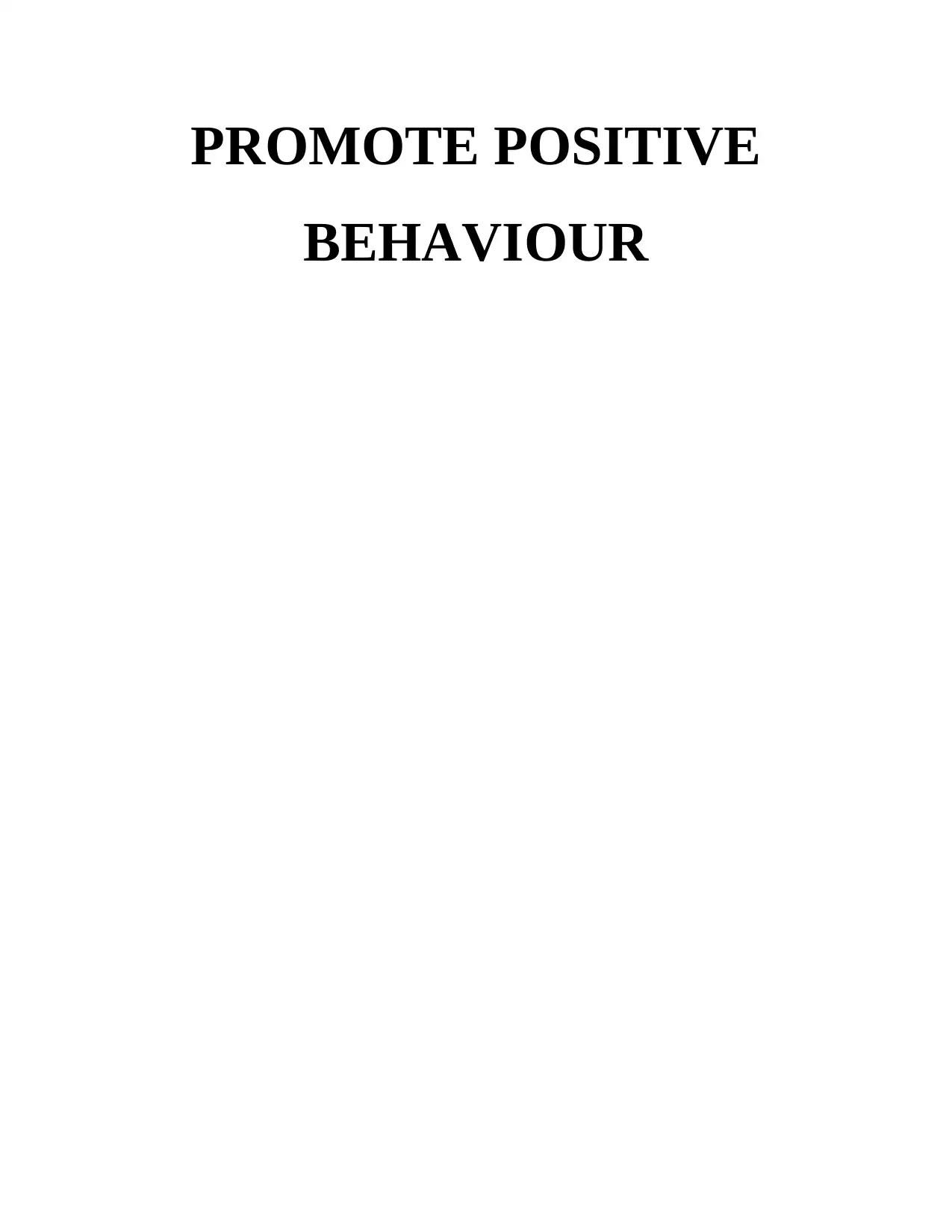
PROMOTE POSITIVE
BEHAVIOUR
BEHAVIOUR
Secure Best Marks with AI Grader
Need help grading? Try our AI Grader for instant feedback on your assignments.
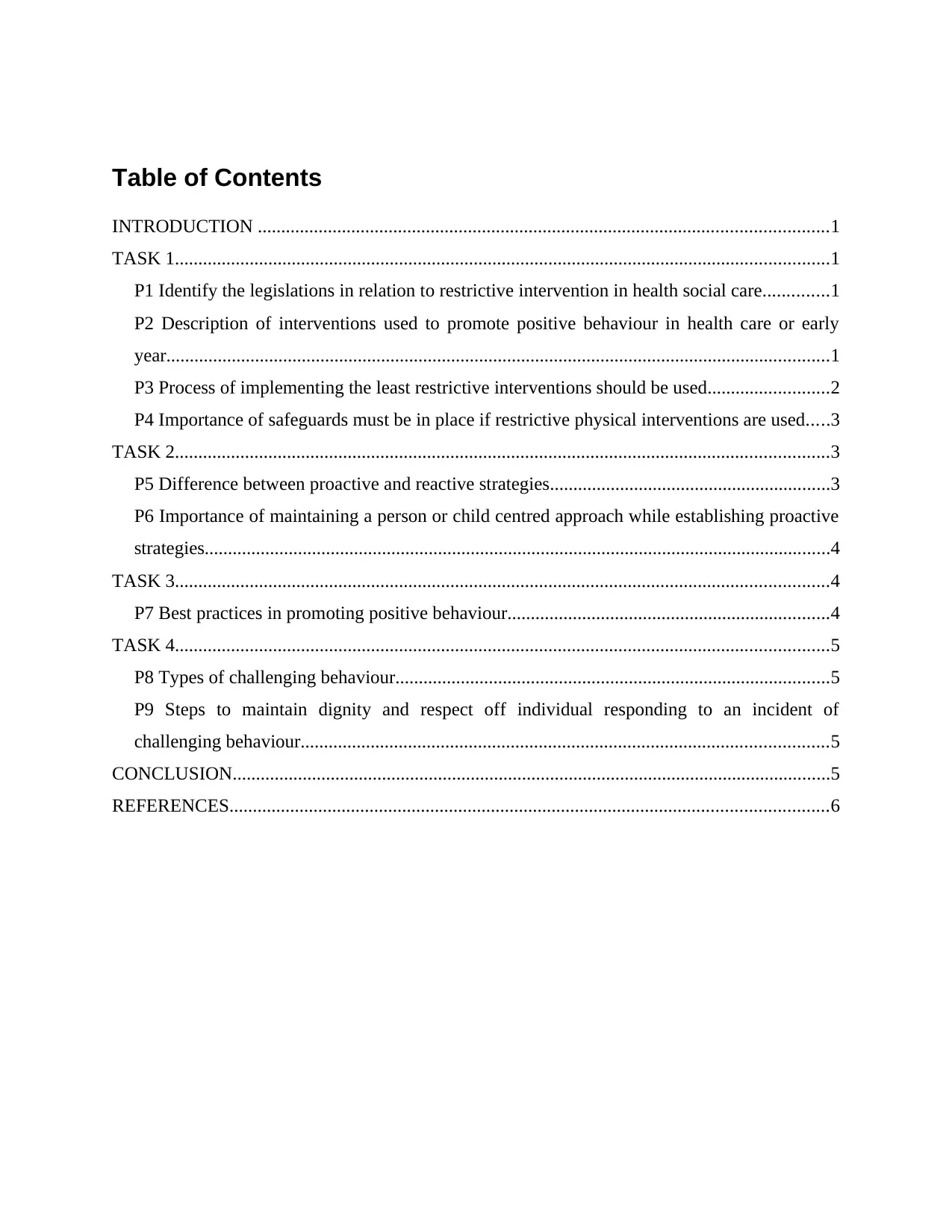
Table of Contents
INTRODUCTION ..........................................................................................................................1
TASK 1............................................................................................................................................1
P1 Identify the legislations in relation to restrictive intervention in health social care..............1
P2 Description of interventions used to promote positive behaviour in health care or early
year..............................................................................................................................................1
P3 Process of implementing the least restrictive interventions should be used..........................2
P4 Importance of safeguards must be in place if restrictive physical interventions are used.....3
TASK 2............................................................................................................................................3
P5 Difference between proactive and reactive strategies............................................................3
P6 Importance of maintaining a person or child centred approach while establishing proactive
strategies......................................................................................................................................4
TASK 3............................................................................................................................................4
P7 Best practices in promoting positive behaviour.....................................................................4
TASK 4............................................................................................................................................5
P8 Types of challenging behaviour.............................................................................................5
P9 Steps to maintain dignity and respect off individual responding to an incident of
challenging behaviour.................................................................................................................5
CONCLUSION................................................................................................................................5
REFERENCES................................................................................................................................6
INTRODUCTION ..........................................................................................................................1
TASK 1............................................................................................................................................1
P1 Identify the legislations in relation to restrictive intervention in health social care..............1
P2 Description of interventions used to promote positive behaviour in health care or early
year..............................................................................................................................................1
P3 Process of implementing the least restrictive interventions should be used..........................2
P4 Importance of safeguards must be in place if restrictive physical interventions are used.....3
TASK 2............................................................................................................................................3
P5 Difference between proactive and reactive strategies............................................................3
P6 Importance of maintaining a person or child centred approach while establishing proactive
strategies......................................................................................................................................4
TASK 3............................................................................................................................................4
P7 Best practices in promoting positive behaviour.....................................................................4
TASK 4............................................................................................................................................5
P8 Types of challenging behaviour.............................................................................................5
P9 Steps to maintain dignity and respect off individual responding to an incident of
challenging behaviour.................................................................................................................5
CONCLUSION................................................................................................................................5
REFERENCES................................................................................................................................6
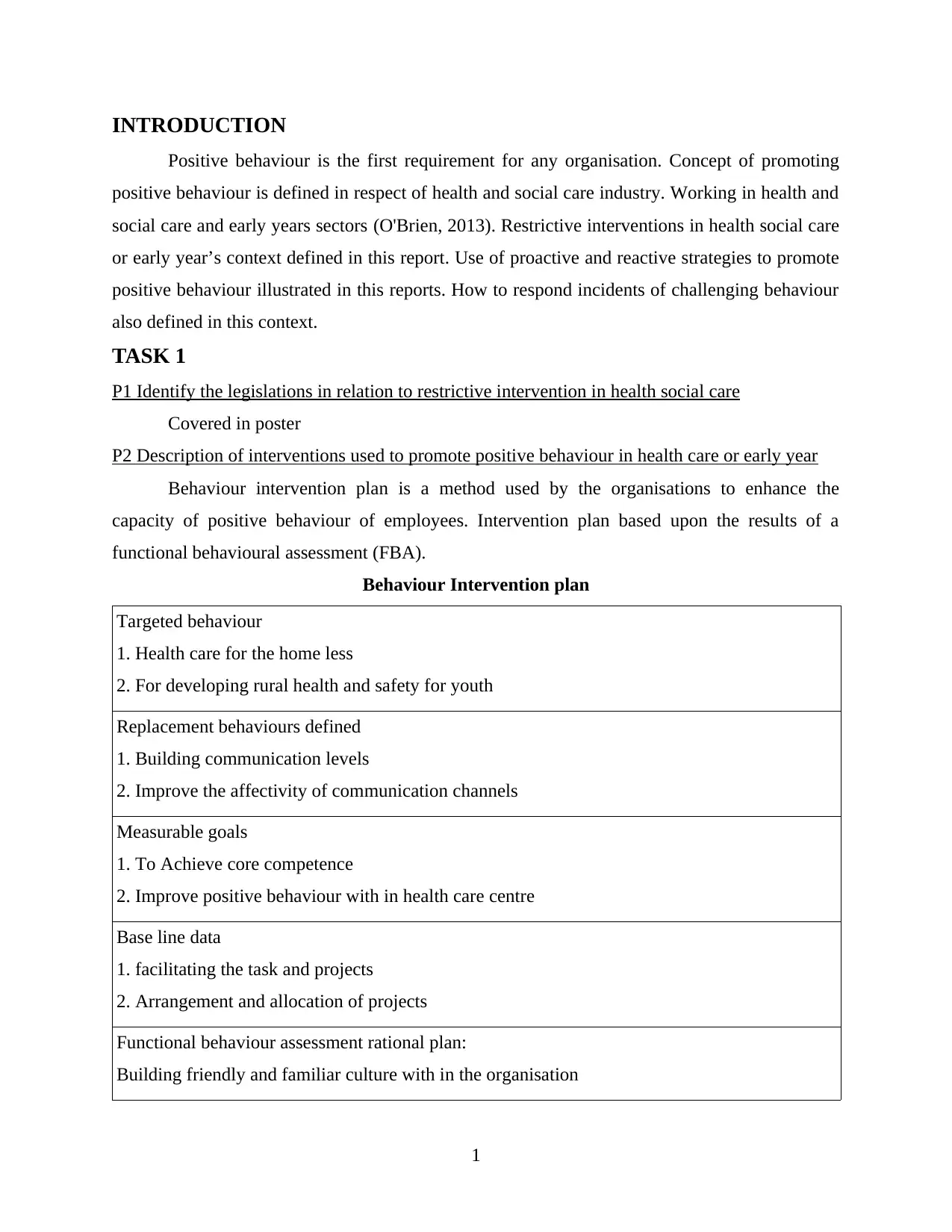
INTRODUCTION
Positive behaviour is the first requirement for any organisation. Concept of promoting
positive behaviour is defined in respect of health and social care industry. Working in health and
social care and early years sectors (O'Brien, 2013). Restrictive interventions in health social care
or early year’s context defined in this report. Use of proactive and reactive strategies to promote
positive behaviour illustrated in this reports. How to respond incidents of challenging behaviour
also defined in this context.
TASK 1
P1 Identify the legislations in relation to restrictive intervention in health social care
Covered in poster
P2 Description of interventions used to promote positive behaviour in health care or early year
Behaviour intervention plan is a method used by the organisations to enhance the
capacity of positive behaviour of employees. Intervention plan based upon the results of a
functional behavioural assessment (FBA).
Behaviour Intervention plan
Targeted behaviour
1. Health care for the home less
2. For developing rural health and safety for youth
Replacement behaviours defined
1. Building communication levels
2. Improve the affectivity of communication channels
Measurable goals
1. To Achieve core competence
2. Improve positive behaviour with in health care centre
Base line data
1. facilitating the task and projects
2. Arrangement and allocation of projects
Functional behaviour assessment rational plan:
Building friendly and familiar culture with in the organisation
1
Positive behaviour is the first requirement for any organisation. Concept of promoting
positive behaviour is defined in respect of health and social care industry. Working in health and
social care and early years sectors (O'Brien, 2013). Restrictive interventions in health social care
or early year’s context defined in this report. Use of proactive and reactive strategies to promote
positive behaviour illustrated in this reports. How to respond incidents of challenging behaviour
also defined in this context.
TASK 1
P1 Identify the legislations in relation to restrictive intervention in health social care
Covered in poster
P2 Description of interventions used to promote positive behaviour in health care or early year
Behaviour intervention plan is a method used by the organisations to enhance the
capacity of positive behaviour of employees. Intervention plan based upon the results of a
functional behavioural assessment (FBA).
Behaviour Intervention plan
Targeted behaviour
1. Health care for the home less
2. For developing rural health and safety for youth
Replacement behaviours defined
1. Building communication levels
2. Improve the affectivity of communication channels
Measurable goals
1. To Achieve core competence
2. Improve positive behaviour with in health care centre
Base line data
1. facilitating the task and projects
2. Arrangement and allocation of projects
Functional behaviour assessment rational plan:
Building friendly and familiar culture with in the organisation
1
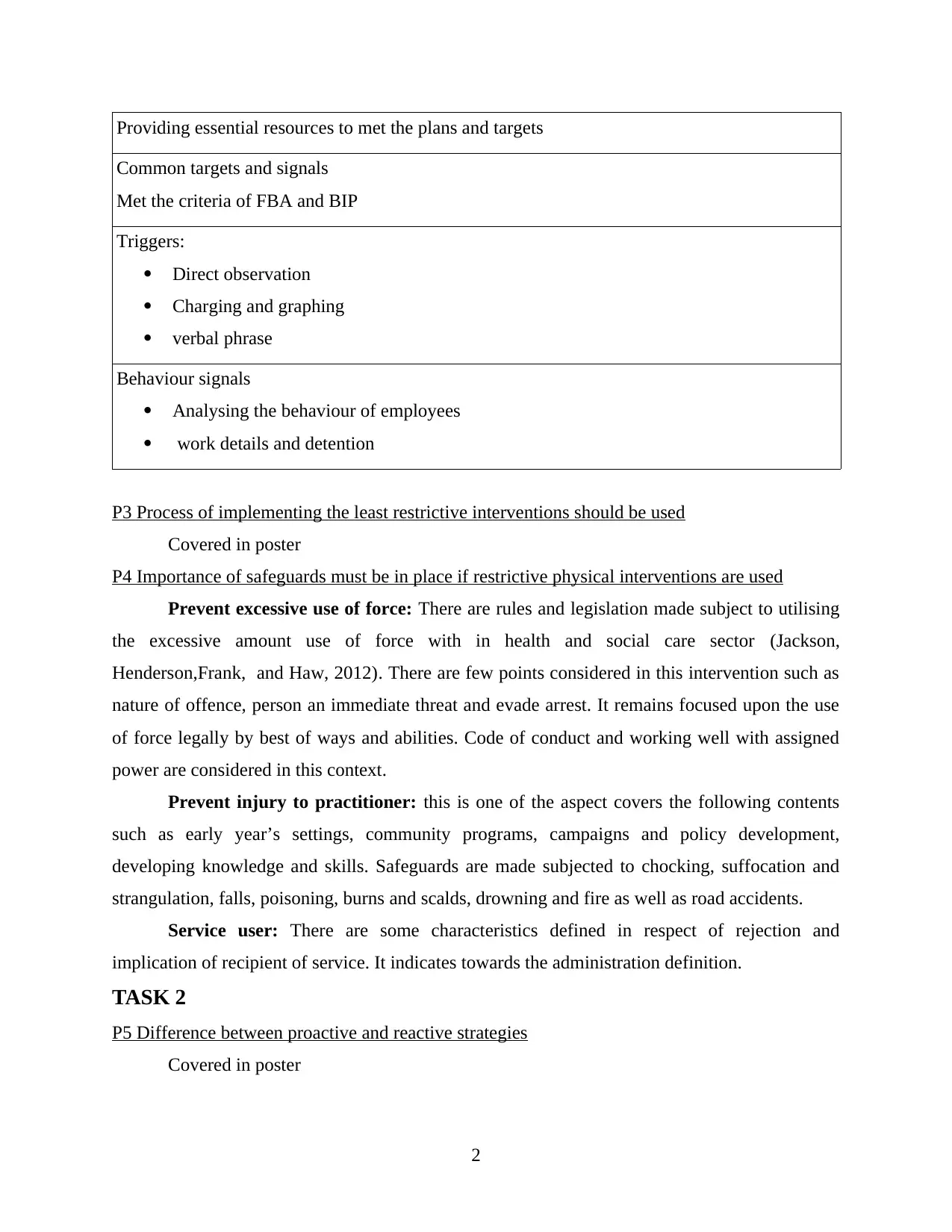
Providing essential resources to met the plans and targets
Common targets and signals
Met the criteria of FBA and BIP
Triggers:
Direct observation
Charging and graphing
verbal phrase
Behaviour signals
Analysing the behaviour of employees
work details and detention
P3 Process of implementing the least restrictive interventions should be used
Covered in poster
P4 Importance of safeguards must be in place if restrictive physical interventions are used
Prevent excessive use of force: There are rules and legislation made subject to utilising
the excessive amount use of force with in health and social care sector (Jackson,
Henderson,Frank, and Haw, 2012). There are few points considered in this intervention such as
nature of offence, person an immediate threat and evade arrest. It remains focused upon the use
of force legally by best of ways and abilities. Code of conduct and working well with assigned
power are considered in this context.
Prevent injury to practitioner: this is one of the aspect covers the following contents
such as early year’s settings, community programs, campaigns and policy development,
developing knowledge and skills. Safeguards are made subjected to chocking, suffocation and
strangulation, falls, poisoning, burns and scalds, drowning and fire as well as road accidents.
Service user: There are some characteristics defined in respect of rejection and
implication of recipient of service. It indicates towards the administration definition.
TASK 2
P5 Difference between proactive and reactive strategies
Covered in poster
2
Common targets and signals
Met the criteria of FBA and BIP
Triggers:
Direct observation
Charging and graphing
verbal phrase
Behaviour signals
Analysing the behaviour of employees
work details and detention
P3 Process of implementing the least restrictive interventions should be used
Covered in poster
P4 Importance of safeguards must be in place if restrictive physical interventions are used
Prevent excessive use of force: There are rules and legislation made subject to utilising
the excessive amount use of force with in health and social care sector (Jackson,
Henderson,Frank, and Haw, 2012). There are few points considered in this intervention such as
nature of offence, person an immediate threat and evade arrest. It remains focused upon the use
of force legally by best of ways and abilities. Code of conduct and working well with assigned
power are considered in this context.
Prevent injury to practitioner: this is one of the aspect covers the following contents
such as early year’s settings, community programs, campaigns and policy development,
developing knowledge and skills. Safeguards are made subjected to chocking, suffocation and
strangulation, falls, poisoning, burns and scalds, drowning and fire as well as road accidents.
Service user: There are some characteristics defined in respect of rejection and
implication of recipient of service. It indicates towards the administration definition.
TASK 2
P5 Difference between proactive and reactive strategies
Covered in poster
2
Secure Best Marks with AI Grader
Need help grading? Try our AI Grader for instant feedback on your assignments.
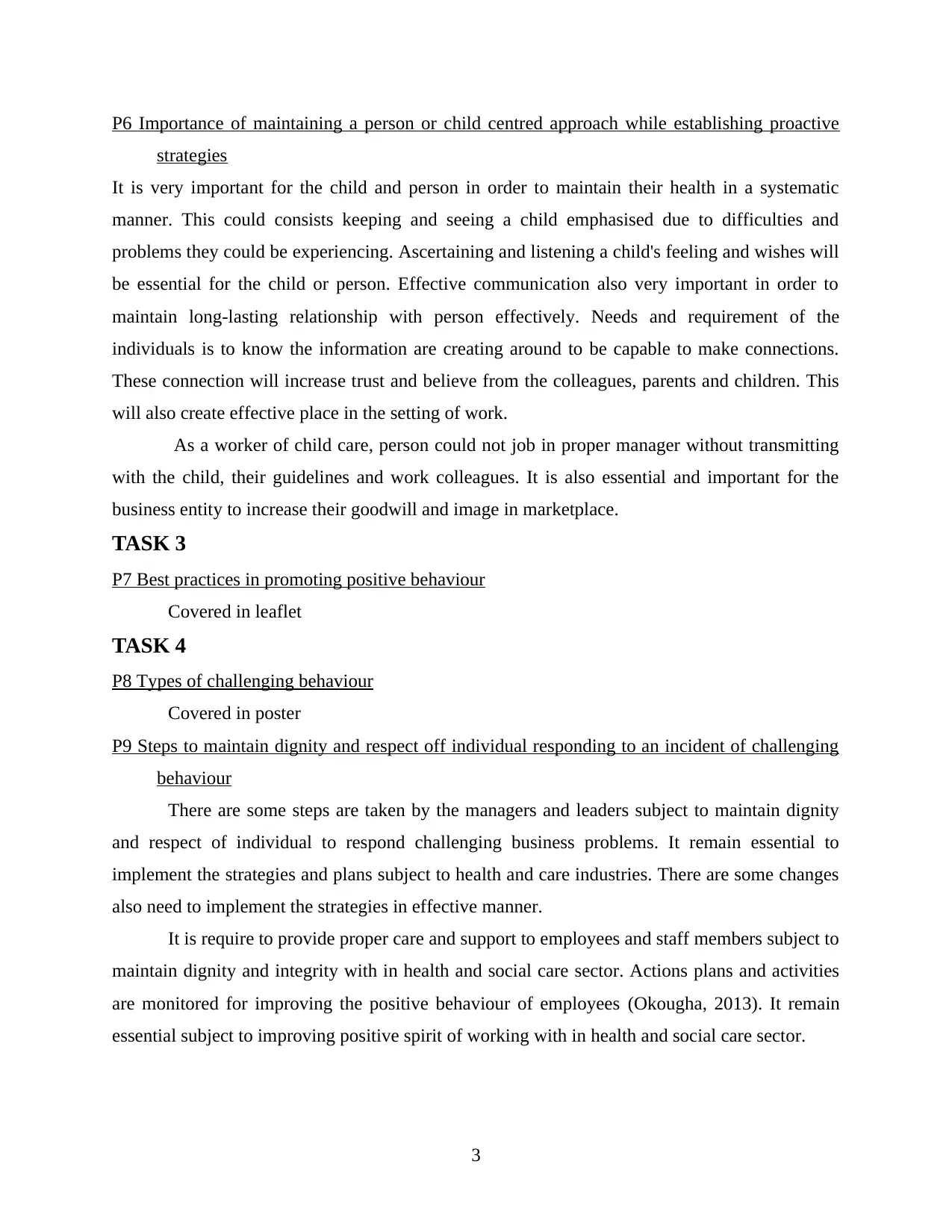
P6 Importance of maintaining a person or child centred approach while establishing proactive
strategies
It is very important for the child and person in order to maintain their health in a systematic
manner. This could consists keeping and seeing a child emphasised due to difficulties and
problems they could be experiencing. Ascertaining and listening a child's feeling and wishes will
be essential for the child or person. Effective communication also very important in order to
maintain long-lasting relationship with person effectively. Needs and requirement of the
individuals is to know the information are creating around to be capable to make connections.
These connection will increase trust and believe from the colleagues, parents and children. This
will also create effective place in the setting of work.
As a worker of child care, person could not job in proper manager without transmitting
with the child, their guidelines and work colleagues. It is also essential and important for the
business entity to increase their goodwill and image in marketplace.
TASK 3
P7 Best practices in promoting positive behaviour
Covered in leaflet
TASK 4
P8 Types of challenging behaviour
Covered in poster
P9 Steps to maintain dignity and respect off individual responding to an incident of challenging
behaviour
There are some steps are taken by the managers and leaders subject to maintain dignity
and respect of individual to respond challenging business problems. It remain essential to
implement the strategies and plans subject to health and care industries. There are some changes
also need to implement the strategies in effective manner.
It is require to provide proper care and support to employees and staff members subject to
maintain dignity and integrity with in health and social care sector. Actions plans and activities
are monitored for improving the positive behaviour of employees (Okougha, 2013). It remain
essential subject to improving positive spirit of working with in health and social care sector.
3
strategies
It is very important for the child and person in order to maintain their health in a systematic
manner. This could consists keeping and seeing a child emphasised due to difficulties and
problems they could be experiencing. Ascertaining and listening a child's feeling and wishes will
be essential for the child or person. Effective communication also very important in order to
maintain long-lasting relationship with person effectively. Needs and requirement of the
individuals is to know the information are creating around to be capable to make connections.
These connection will increase trust and believe from the colleagues, parents and children. This
will also create effective place in the setting of work.
As a worker of child care, person could not job in proper manager without transmitting
with the child, their guidelines and work colleagues. It is also essential and important for the
business entity to increase their goodwill and image in marketplace.
TASK 3
P7 Best practices in promoting positive behaviour
Covered in leaflet
TASK 4
P8 Types of challenging behaviour
Covered in poster
P9 Steps to maintain dignity and respect off individual responding to an incident of challenging
behaviour
There are some steps are taken by the managers and leaders subject to maintain dignity
and respect of individual to respond challenging business problems. It remain essential to
implement the strategies and plans subject to health and care industries. There are some changes
also need to implement the strategies in effective manner.
It is require to provide proper care and support to employees and staff members subject to
maintain dignity and integrity with in health and social care sector. Actions plans and activities
are monitored for improving the positive behaviour of employees (Okougha, 2013). It remain
essential subject to improving positive spirit of working with in health and social care sector.
3
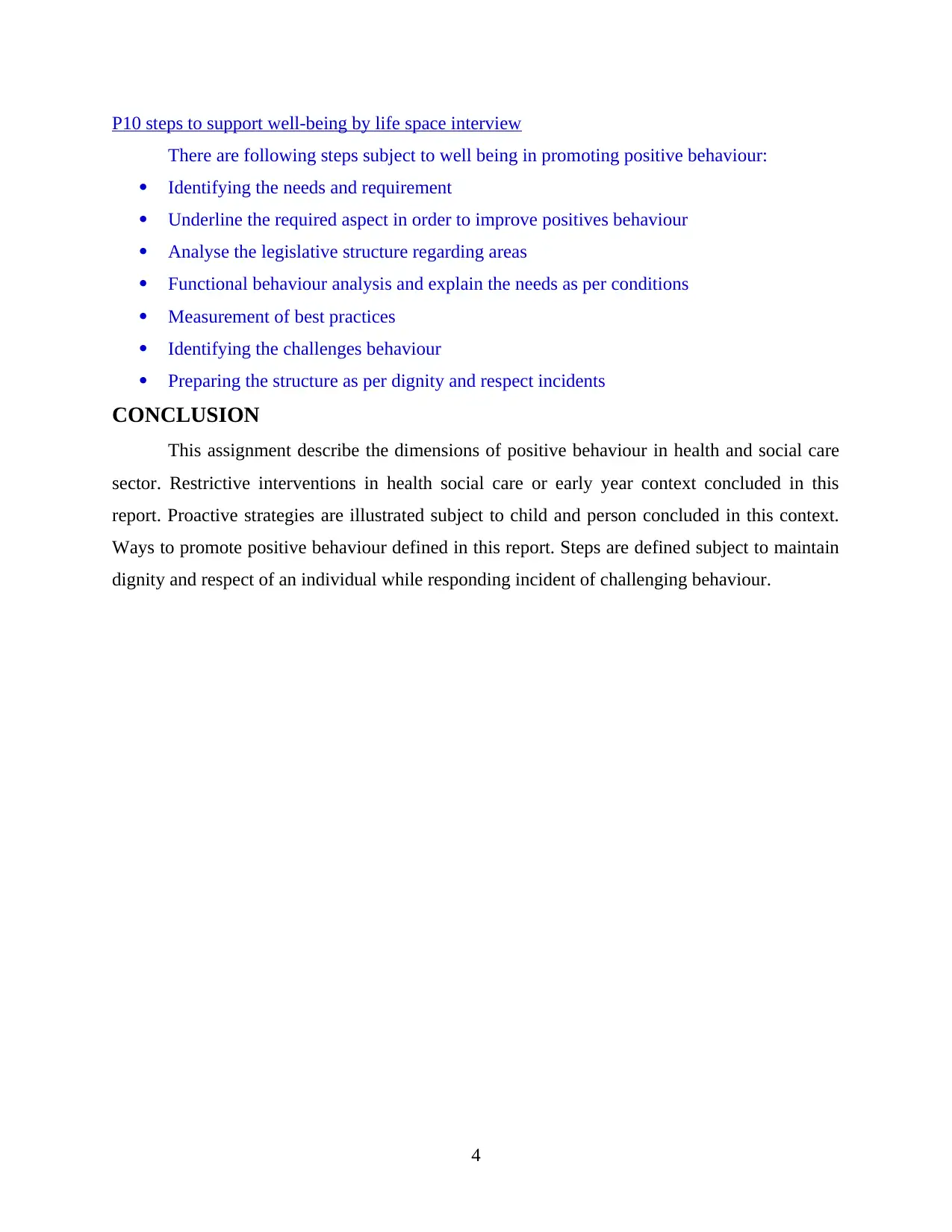
P10 steps to support well-being by life space interview
There are following steps subject to well being in promoting positive behaviour:
Identifying the needs and requirement
Underline the required aspect in order to improve positives behaviour
Analyse the legislative structure regarding areas
Functional behaviour analysis and explain the needs as per conditions
Measurement of best practices
Identifying the challenges behaviour
Preparing the structure as per dignity and respect incidents
CONCLUSION
This assignment describe the dimensions of positive behaviour in health and social care
sector. Restrictive interventions in health social care or early year context concluded in this
report. Proactive strategies are illustrated subject to child and person concluded in this context.
Ways to promote positive behaviour defined in this report. Steps are defined subject to maintain
dignity and respect of an individual while responding incident of challenging behaviour.
4
There are following steps subject to well being in promoting positive behaviour:
Identifying the needs and requirement
Underline the required aspect in order to improve positives behaviour
Analyse the legislative structure regarding areas
Functional behaviour analysis and explain the needs as per conditions
Measurement of best practices
Identifying the challenges behaviour
Preparing the structure as per dignity and respect incidents
CONCLUSION
This assignment describe the dimensions of positive behaviour in health and social care
sector. Restrictive interventions in health social care or early year context concluded in this
report. Proactive strategies are illustrated subject to child and person concluded in this context.
Ways to promote positive behaviour defined in this report. Steps are defined subject to maintain
dignity and respect of an individual while responding incident of challenging behaviour.
4
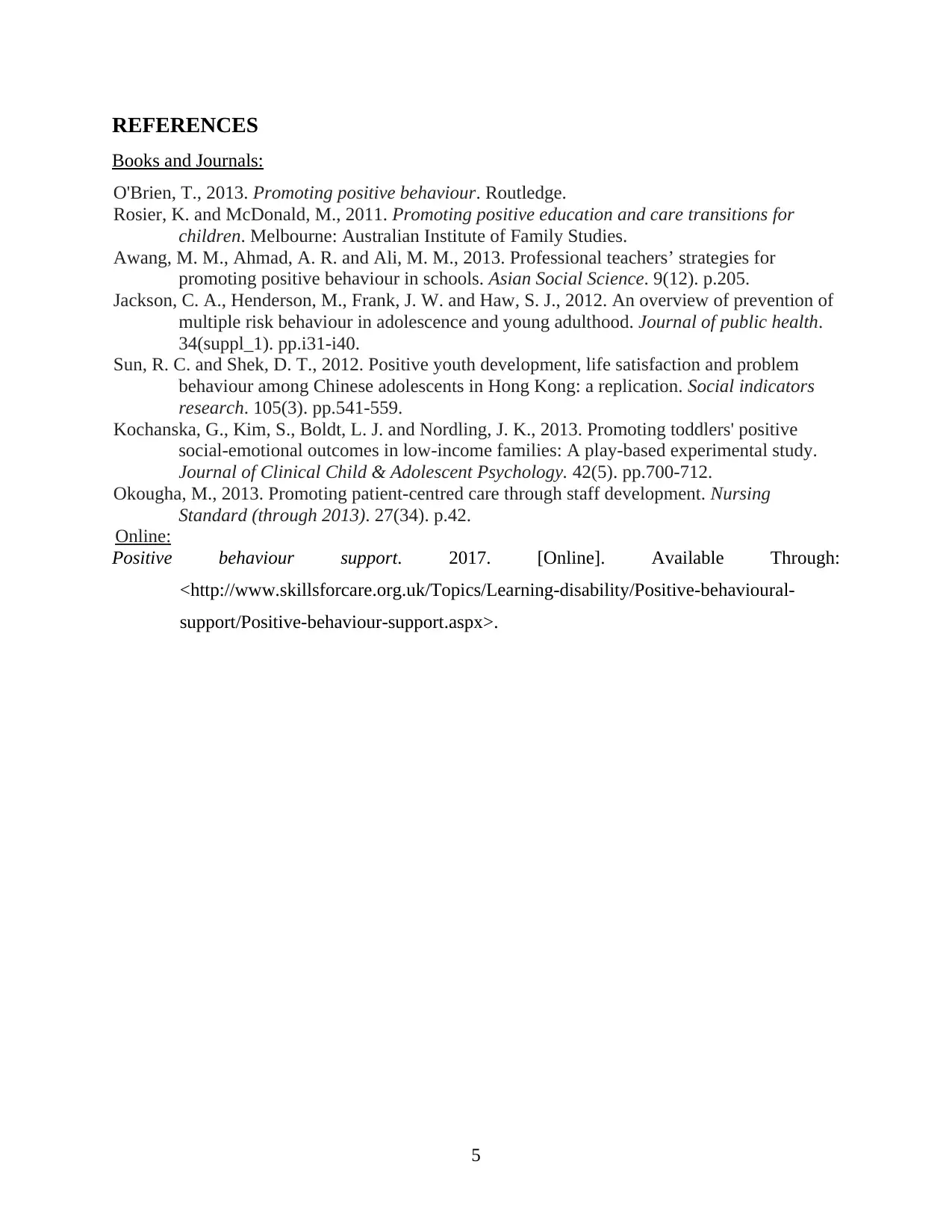
REFERENCES
Books and Journals:
O'Brien, T., 2013. Promoting positive behaviour. Routledge.
Rosier, K. and McDonald, M., 2011. Promoting positive education and care transitions for
children. Melbourne: Australian Institute of Family Studies.
Awang, M. M., Ahmad, A. R. and Ali, M. M., 2013. Professional teachers’ strategies for
promoting positive behaviour in schools. Asian Social Science. 9(12). p.205.
Jackson, C. A., Henderson, M., Frank, J. W. and Haw, S. J., 2012. An overview of prevention of
multiple risk behaviour in adolescence and young adulthood. Journal of public health.
34(suppl_1). pp.i31-i40.
Sun, R. C. and Shek, D. T., 2012. Positive youth development, life satisfaction and problem
behaviour among Chinese adolescents in Hong Kong: a replication. Social indicators
research. 105(3). pp.541-559.
Kochanska, G., Kim, S., Boldt, L. J. and Nordling, J. K., 2013. Promoting toddlers' positive
social-emotional outcomes in low-income families: A play-based experimental study.
Journal of Clinical Child & Adolescent Psychology. 42(5). pp.700-712.
Okougha, M., 2013. Promoting patient-centred care through staff development. Nursing
Standard (through 2013). 27(34). p.42.
Online:
Positive behaviour support. 2017. [Online]. Available Through:
<http://www.skillsforcare.org.uk/Topics/Learning-disability/Positive-behavioural-
support/Positive-behaviour-support.aspx>.
5
Books and Journals:
O'Brien, T., 2013. Promoting positive behaviour. Routledge.
Rosier, K. and McDonald, M., 2011. Promoting positive education and care transitions for
children. Melbourne: Australian Institute of Family Studies.
Awang, M. M., Ahmad, A. R. and Ali, M. M., 2013. Professional teachers’ strategies for
promoting positive behaviour in schools. Asian Social Science. 9(12). p.205.
Jackson, C. A., Henderson, M., Frank, J. W. and Haw, S. J., 2012. An overview of prevention of
multiple risk behaviour in adolescence and young adulthood. Journal of public health.
34(suppl_1). pp.i31-i40.
Sun, R. C. and Shek, D. T., 2012. Positive youth development, life satisfaction and problem
behaviour among Chinese adolescents in Hong Kong: a replication. Social indicators
research. 105(3). pp.541-559.
Kochanska, G., Kim, S., Boldt, L. J. and Nordling, J. K., 2013. Promoting toddlers' positive
social-emotional outcomes in low-income families: A play-based experimental study.
Journal of Clinical Child & Adolescent Psychology. 42(5). pp.700-712.
Okougha, M., 2013. Promoting patient-centred care through staff development. Nursing
Standard (through 2013). 27(34). p.42.
Online:
Positive behaviour support. 2017. [Online]. Available Through:
<http://www.skillsforcare.org.uk/Topics/Learning-disability/Positive-behavioural-
support/Positive-behaviour-support.aspx>.
5
1 out of 7
Related Documents
Your All-in-One AI-Powered Toolkit for Academic Success.
+13062052269
info@desklib.com
Available 24*7 on WhatsApp / Email
![[object Object]](/_next/static/media/star-bottom.7253800d.svg)
Unlock your academic potential
© 2024 | Zucol Services PVT LTD | All rights reserved.





